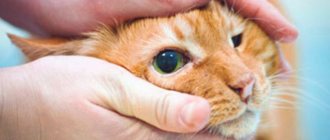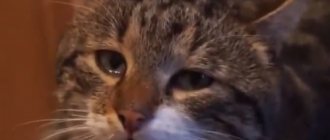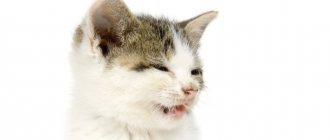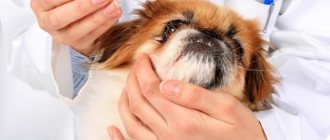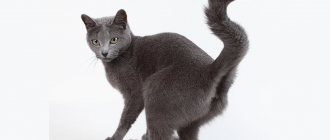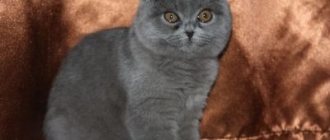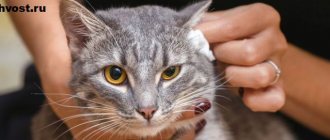For various reasons, cats' eyes often begin to fester. This may indicate either an eye disease or a serious illness in the animal. The owner of every pet should know how to treat a cat and how to find out the cause of eye infection.
If you don’t know how to treat a cat’s eyes, then read this article.
In this article, you will get acquainted with the most common causes of eye suppuration and methods of treating this disease.
Causes of pus in the eyes of cats
All causes of eye suppuration in cats can be divided into several large groups:
- Mechanical damage to the retina. Accompanied by temporary inflammation followed by watery discharge. The latter accumulate in the inner corners of the eye in the form of small, hard brown or black lumps.
- Chemical exposure that causes an animal to develop blepharitis (inflammation of the edges of the eyelids).
- Colds or allergies are often accompanied by clear or white mucous discharge from the nose and eyes.
- The body's response to the action of pathogenic microorganisms. The discharge is yellowish-green in color and is recognized by the specific smell of pus.
- The result of a complication of conjunctivitis that occurs when a veterinarian is not consulted in a timely manner.
- Helminthiasis. In addition to the main parasitic factor, helminths poison the animal’s body with the products of their vital activity. As a result, an allergic reaction occurs, accompanied by mucus from the nose and suppuration of the eyes.
We recommend reading the article about eye diseases in cats to understand the topic in more detail.
Suppuration: normal or pathological?
Eye discharge does not always appear due to pathological processes developing in the body.
In some cases, pus in a cat accumulates under the eyelids for the following reasons:
- weakened immune system;
- improperly selected diet (lack of nutrients);
- infectious, viral damage;
- unsanitary conditions when keeping animals;
- draft;
- eye injuries;
- allergic reaction to household chemicals, perfumes;
- inflammatory processes in the cornea (keratitis);
- dust in the room where the pet is kept.
On a note! If the discharge is abundant and prolonged, you should not resort to self-medication; the animal must be taken for examination to a veterinary clinic, where the doctor will determine the cause and prescribe adequate treatment.
The owner should pay attention to the color of the discharge. Rare discharge of a grayish tint is normal, and thick discharge of a yellowish or green tint most likely indicates the development of pathological processes in the body.
Symptoms
An experienced owner always pays attention to the behavior of his pet. Symptoms:
- Loss of appetite, general lethargy, increased sleep duration.
- Increased body temperature.
- Preference for dark, secluded places due to increased sensitivity to light.
- Squinting or closing your eyes most of the time.
- The presence of a specific odor.
- The appearance of a rare cough, redness of the mucous membrane, runny nose.
Rating of medicines for barley
Tetracycline eye ointment 1% tube 3 g
Manufacturer: Tatkhimpharmpreparaty, Russia
Dancil eye and ear drops 0.3% dropper bottle 5 ml
Manufacturer: Sentiss, India
- blepharitis;
- barley;
- conjunctivitis;
- dacryocystitis;
- keratitis;
- corneal ulcer;
- chlamydial eye infection.
Floxal eye drops 0.3% dropper bottle 5 ml
Manufacturer: Dr. Gerhard Mann, Germany
- acute and subacute conjunctivitis;
- blepharoconjunctivitis, blepharitis;
- bacterial corneal ulcers;
- bacterial keratitis and keratoconjunctivitis;
- chronic dacryocystitis and meibomitis.
- Preoperative prophylaxis in ophthalmic surgery. Treatment of postoperative infectious complications.
- viral keratitis;
- pregnancy;
- lactation period (breastfeeding);
- children under 1 year of age;
- hypersensitivity to the components of the drug;
- hypersensitivity to other drugs of the quinolone group.
Tsiprolet eye drops 0.003 5 ml
Manufacturer: Dr. Reddy's Laboratories, India
- blepharitis;
- barley;
- conjunctivitis;
- dacryocystitis;
- keratitis;
- corneal ulcer;
- chlamydial eye infection.
- pregnancy;
- lactation period (breastfeeding);
- hypersensitivity to the components of the drug.
Floxal eye ointment 0.3% dropper bottle 3 g
Manufacturer: Dr. Gerhard Mann, Germany
Carefully
Erythromycin ophthalmic ointment 10 thousand units/g tube 10 g. Manufacturer: Tatkhimfarmpreparaty, Russia
Manufacturer: Tatkhimpharmpreparaty, Russia
No. 7 Okomistin eye, ear, nasal drops 0.01% 10 ml, Infamed LLC, Russia
Ophthalmology
- in the complex treatment of infectious processes in the anterior part of the eye (blepharitis, conjunctivitis, keratitis, keratouveitis), eye injuries, eye burns (thermal and chemical);
- in the preoperative and postoperative periods for the treatment and prevention of purulent-inflammatory eye lesions;
Otorhinolaryngology
- in the complex treatment of acute sinusitis/rhinosinusitis, exacerbation of chronic sinusitis/rhinosinusitis, acute rhinitis;
- in the complex treatment of acute and chronic external otitis, chronic purulent mesotympanitis, otomycosis.
Ophthalmology Otorhinolaryngology
Okomistin eye, ear, nasal drops 0.01% 10 ml
Manufacturer: Infamed LLC, Russia
Ciprofloxacin dropper bottle 0.3% 10 ml
Manufacturer: Renewal, Russia
No. 9 Ciprofloxacin-Akos eye drops 0.3% 5 ml, Sintez OJSC, Russia
- acute and subacute conjunctivitis;
- blepharitis, blepharoconjunctivitis;
- keratitis, keratoconjunctivitis;
- bacterial corneal ulcer;
- chronic dacryocystitis;
- meibomite;
- infectious eye lesions after injury or foreign bodies;
- pre- and postoperative prevention of infectious complications in ophthalmic surgery.
- viral keratitis;
- children under 1 year of age;
- individual sensitivity to the components of the drug.
Ciprofloxacin-Akos eye drops 0.3% 5 ml
Manufacturer: Sintez OJSC, Russia
Ciprofloxacin Optic eye drops 0.3% dropper bottle 5 ml
Manufacturer: Lecco, Russia
No. 11 Tsipromed eye drops 0.3% dropper bottle 5 ml, Sentiss, India
- acute and subacute conjunctivitis;
- keratitis;
- anterior uveitis;
- blepharitis and other inflammatory diseases of the eyelids;
- dacryocystitis.
Tsipromed eye drops 0.3% dropper bottle 5 ml
Manufacturer: Sentiss, India
No. 12 Combined eye and ear drops, dropper bottle 5 ml, Sentiss, India
- acute and subacute conjunctivitis;
- keratitis;
- anterior uveitis;
- blepharitis and other inflammatory diseases of the eyelids;
- prevention and treatment of infectious complications after injuries to the eye and its appendages and during operations on the eyeball.
- acute external otitis media;
- acute otitis media with eardrum shunt;
- acute otitis media with granulations and otorrhea in the presence of an eardrum shunt.
Combined eye and ear drops 5 ml dropper bottle
Manufacturer: Sentiss, India
No. 13 Sofradex eye and ear drops 5 ml, Sanofi Aventis, India
- blepharitis;
- conjunctivitis;
- keratitis (without damage to the epithelium);
- iridocyclitis;
- sclerites, episclerites;
- infected eczema of the eyelid skin;
- otitis externa.
Sofradex eye and ear drops 5 ml
Manufacturer: Sanofi Aventis, India
Diagnostics
If primary suppuration occurs, the owner should immediately contact a qualified specialist, preferably a specialist, an ophthalmologist. Time and strict adherence to the doctor’s instructions play an important role in the favorable outcome of treatment.
You should take eye diseases in newborn kittens especially seriously, because... complications later will pose an even greater danger.
Without laboratory tests and an integrated approach, it is impossible to be sure that the diagnosis is correct. Unfortunately, not all owners remember this, preferring self-medication at home to an experienced veterinarian.
Why it occurs: reasons
Reference! With ARVI and colds, the upper respiratory tract is affected by microscopic pathogens that carry out active life activities.
The viral infection spreads to the mucous membranes of the eye by sneezing, coughing, blowing the nose, as well as by touching the eyelids with dirty hands and by not observing personal hygiene rules.
Conjunctivitis
occurs as a complication of a cold with weak immunity, or against the background of an advanced cold , suffered “on the feet” without proper treatment.
In people with initially strong immunity and with timely treatment of ARVI, such complications usually do not occur.
Treatment methods
It is important to remember that the success of recovery directly depends on the accuracy of the diagnosis and the person’s willingness to fully comply with the instructions.
Recommendations:
- For a complete diagnosis, the doctor requires an anamnesis, i.e. information about the cat: what conditions the pet lives in, its diet, previous diseases, behavioral characteristics, proximity to other animals.
- It is advisable to wash your cat’s eyes with a warm chamomile solution before visiting the veterinary clinic.
- Depending on the causes of suppuration, the doctor may use several treatment approaches. In case of prolonged and profuse discharge from the eyes and nose, as a rule, a novocaine blockade with the administration of an antibiotic is prescribed. If discharge from the eyes is the result of mechanical damage, use Levomycetin drops for an adult cat or Albucid for one-month-old kittens.
What to do if a kitten’s eyes fester: first aid and treatment
The first thing you need to do is wash the kitten's eyes. At home, this can be done with a gauze swab moistened with chamomile decoction or brewing loose-leaf black tea. If there is no effect from washing, you should show your pet to a veterinarian.
How to wash a kitten's eyes if they fester
The choice of rinsing agent depends on the cause of the suppuration. How to treat a kitten whose eyes are festering cannot be said without a veterinarian’s opinion. Only a doctor has the right to prescribe certain medications and calculate the dosage. What the vet usually recommends:
- If the eyelids are bruised or wounded, the damaged part is cleaned with a solution of hydrogen peroxide. Sometimes rinsing alone is not enough - injections or tablets may be prescribed.
- If the discharge is caused by a cold, then the kitten is provided with a dry and warm sleeping place, without drafts and hypothermia, vitamins are added to the diet and eye drops are prescribed from a veterinary pharmacy (Leopard, Iris, etc.).
- If the crusts interfere with the opening of the eyes, they are softened and removed with petroleum jelly.
- Before instillation, the eyes are washed with a weak solution of furatsilin, and hydrogen peroxide is used to treat the skin around the eyes. For severe infections, antibiotics are prescribed. Most drugs are used topically as eye drops.
If the kitten has contracted the virus, then therapy will focus on expelling it from the body. After recovery, the eyes will return to normal on their own - the purulent discharge will stop. A sick baby will have to be injected with antiviral drugs, antibiotics, vitamin complexes, and in case of exhaustion, nutritional droppers will be needed.
Drops and ointments
If discharge from the eyes is caused by a malfunction of the internal organs or viruses, the drops will be an auxiliary treatment that relieves unpleasant symptoms. Eye diseases are mainly treated with drops and ointments.
For localized purulent discharge from the eyes, the following ointments are used: tetraclycine, erythromycin, chloramphenicol, sofradex, misofen and others. They last longer than drops due to their dense consistency, and are usually used 2 times a day for no more than two weeks.
Drops from a veterinary pharmacy are Iris, Bars, Dekta, Tsiprovet, Barrier, etc. They wash out faster, but are easier to use than ointment. Drops are prescribed as a primary or additional remedy that relieves itching and inflammation and washes the pet's eye.
For more serious conditions, such as purulent conjunctivitis, your veterinarian may prescribe antibiotics. The treatment regimen will directly depend on the type of inflammation.
The main thing: do not self-medicate! This can only make things worse.
How to properly rinse and apply eye drops
Remember that before applying the medications you need to clear the eye of pus and discharge. To do this, just take a cotton pad, moisten it in a solution of furatsilin or saline and move it from the outer corner (from the ear) to the inner one. There should be a separate cotton pad for each eye.
To put drops in a kitten’s eyes without harming or scaring him, you need to wrap him in soft cloth, lay him with his muzzle up and raise his head so that his eyes look straight. After this, the lower eyelid of the diseased eye is slightly pulled back and the drug is applied to the mucous membrane.
If the drug is in the form of a thick ointment, you can cover the eye and lightly massage it through the eyelid so that the medicine spreads better over the cornea.
Even a small kitten can resist an unpleasant procedure. Therefore, if you have a very restless or fearful baby, invite an assistant: he will hold the kitten’s head while you drip the medicine. This will save you from nerves, and the kitten from stress and accidental injuries.
List of recommended drugs
Based on the causes of the disease, the veterinarian most often prescribes the following medications:
- For bruises and injuries - drops of Levomycetin or Iris.
- For swelling - a solution of hydrocortisone and novocaine.
- For acute illness - intramuscular antibiotics.
Prescribing medications for an animal should only be done by a professional after a complete diagnosis. Self-treatment without the guidance of a veterinarian can lead to complications and irreversible pathologies.
Tips for beginners when washing eyes
Eye washing is one of the most important points in the treatment and prevention of disease in any animal.
You can do the procedure yourself at home or go to a veterinary clinic. During a period of illness, a cat is most often reluctant to allow its owner to approach it.
Representatives of the Persian, British and Siamese breeds are especially capricious. In this situation, it is advisable to ask a family member to hold the cat's head during the procedure. It is best to secure it with a towel or diaper.
Recommendations:
- A folded cotton pad or a tight tourniquet is suitable for rinsing. It is better to avoid cotton swabs, as they do not absorb liquid well, have a relatively small surface and can damage the retina when the animal tries to escape.
- For sterility purposes, it is better to prepare separate dishes for washing each eye. For the same reason, you should use a cotton pad no more than once.
- It is not recommended to touch the inflamed surface with a dry disc.
- Hands must be washed.
- All solutions must be at room temperature.
- Keep in mind that a swollen area can often cause pain for your cat.
- The best treatment is comprehensive. After rinsing with the solution/drops, re-treat the inflamed area with ointment.
- You need to repeat washing as often as possible. Step-by-step instructions for washing eyes
- Fix the animal on its side, turning its head up, holding the chin.
- If a crust forms and the eye sticks together, soften the inflamed area with Vaseline oil. Using cotton wool soaked in 3% hydrogen peroxide, remove the discharge, then rinse with the solution and apply eye drops.
- Apply the solution to the eyeball, gently lifting the eyelids.
- Raise and lower the animal's eyelids several times to distribute the medication evenly. Remove excess with a disc.
- Do not forget about nasal discharge, remove it with a cotton pad.
First aid for a pet at home
There are situations when it is impossible or very difficult to get to the veterinarian. In this case, the owner must provide first aid to his pet.
- Washing your eyes is a very important aspect. By washing your eyes, you relieve your baby's suffering. Eyes should be washed only with a warm solution using a cotton pad. After rinsing, your pet should apply an eye ointment, such as tetracycline.
Washing is performed by the following means:
- A decoction of medicinal chamomile;
- Boric acid solution;
- 0.02% furatsilin solution.
- Eye ointment. Before applying the ointment, you need to warm it in your hand. Cold ointment should never be applied to the affected area. The ointment should be applied as follows:
- The kitten should be placed on its side and held tightly. It is best if one person holds the pet while the other applies the medicine.
- Next, you need to carefully pull back the lower eyelid and gently apply the ointment.
- Then, you should massage the eyelid so that the medicine is distributed over the eye.
- You can also put special drops in your pet’s eyes. Which ones you need to find out at your veterinary pharmacy.
Types of tinctures and solutions
Eye solution can be purchased at a pharmacy or prepared independently.
The most effective are:
- Camomile tea. Dilute one tablespoon of dried flowers in a glass of boiling water. Leave for 30 minutes.
- A decoction of strong tea. It is advisable to use whole leaves and distilled water.
- Table salt solution. For a liter of distilled water, take 1/2 teaspoon of salt. The mixture is brought to a boil. Not suitable in case of an allergic reaction.
- Lacrimin or Medkinos solutions, which can always be purchased at a pharmacy at an affordable price.
Medications
- Hydrocortisone drops with novocaine - to relieve swelling, inflammation, pain.
- Gentamicin drops - for severe inflammatory processes.
- Albucid drops - for the treatment of injuries.
- Drops with chloramphenicol - for infectious lesions.
- Drops with atropine - for the development of photophobia.
- Solcoseryl ointment - for healing mucous membranes in case of injuries.
- Tetracycline ointment for allergic reactions, to relieve inflammation.
Choosing eye drops
Unlike infusions, it is impossible to prepare drops at home. You can find the necessary remedy at a veterinary or regular pharmacy.
It is important to remember that neither solutions nor drops can provide a 100% healing effect. The latter are necessary only to slow down the development of the disease.
The most commonly prescribed drugs are:
- Sulfacetamide.
- Levomycetin drops.
- Diamond eyes.
Forms of allergic rhinitis
Doctors distinguish mild, moderate and severe forms of rhinitis.
In the first case, the symptoms are mild, quality sleep, daily quality of life and activity are preserved, and the general condition can be called satisfactory.
In the second case, the symptoms already affect all of the above points. A person is more susceptible to exposure to allergens and experiences discomfort.
When the disease is severe, the symptoms become so painful that the human body cannot function normally.
According to the forms of its course, allergic rhinitis can be intermittent (symptoms persist only up to 3 days a week and up to 4 weeks a year) and persistent (symptoms persist more than 4 days a week and more than 4 weeks a year).
The disease itself can be detected both during an exacerbation and during remission.
Selection of ointments and method of their use
For best effect, it is recommended to use ointments. As a rule, tetracycline ointment (1%) is used.
Apply it as follows:
- First, purulent discharge from the eyes and nose is removed. Gently wash the inflamed areas with a cotton pad soaked in tincture or solution.
- To enhance the effect, the ointment is warmed to room temperature in advance.
- Lightly pull back the cat's lower eyelid, apply ointment to its inner surface, placing the latter with a special spatula.
- The eyelids are closed, massaging in a circular motion to better distribute the ointment over the surface of the swollen eye.
- Remove excess with a cotton pad.
Symptoms of suppuration
Suppuration is visible to the naked eye. Usually the pus dries out and forms a light gray crust. Dried drops form on the fur in the area of the eyes and nose. Too much discharge can even “glue” the eye and it will not open. Kittens will try to remove the formations by washing, but this can only worsen the situation: the infection will spread, and the results will not be the most pleasant.
The pus may be white, yellow, green, or brown. It is important to pay attention if your pet frequently blinks or squints, rubs its eyes with its paws, or sneezes. Older kittens may hide in secluded places. If the baby was active and playful, but suddenly became apathetic, then this is a clear reason to examine him and see a doctor.
Symptoms can tell what disease the kitten’s body has been exposed to. Here are the most common:
- Sour eyes, snot, inflamed and red eyelids. Reason – conjunctivitis. It is divided into four groups according to the nature of the disease.
- Infection occurs against the background of irritation of the mucous membrane (dust, chapping, other external irritants).
- Viral is a symptom of a contagious disease that develops covertly or acutely.
- Chronic occurs when the eyes are dry, the nasolacrimal ducts do not work properly, and ulcers form on the corneas.
- Allergies develop against the background of constant stimulation of the immune system by allergens.
- Purulent eyes, severe runny nose, wet cough, sneezing, upset stomach. The cause is toxoplasmosis , a parasitic disease. Usually occurs in outdoor kittens.
- Swelling, severe pain, the kitten reacts sharply to any touch in the eye area. The reason is blockage of the tear ducts . Usually occurs in babies up to three weeks of age. Pain and discomfort are caused by the accumulation of pathological exudate in the lacrimal canal.
- Swollen eyes, sneezing, coughing, purulent discharge. The cause is chlamydia . The infection affects not only the mucous membranes of the eyes, but also the respiratory tract, digestion and genitals.
- Purulent eyes, cough, rhinitis. The cause is mycoplasmosis . The infection first affects the organs of vision, and then the respiratory system. If treatment is not started in time, the kitten will develop diseases of the genitourinary system, liver and joints.
- Your eyes hurt, tears flow, your eyelids swell. The owner observes that the animal has inflamed eyes, eyelids stuck together from pus and ichor, bleeding and bruising are possible. The reason is injuries . It is important to start treatment in a timely manner, otherwise bacteria will penetrate through small wounds.
Important! Examine a kitten's eyes only with clean hands. It is recommended to wash your hands with laundry soap or disinfect with hydrogen peroxide. This way you can prevent the introduction of even more dangerous viruses.
Preventive measures necessary to avoid eye diseases
Vaccinations and periodic deworming are universal ways to protect any animal. It is also important to consider the breed of the cat.
Some of them, such as the Sphynx, require increased attention to the skin. Having no fur, they are more susceptible to suppuration. Not only do they require daily care and eye washing, but they also need to repeatedly wipe their ears with a warm solution.
The opposite situation is the Persian breed with thick hair. In case of suppuration, snot and other mucous secretions, you should cut off the hair around the swollen organ and, after recovery, carefully ensure that the hair does not fall into the area of the former inflammation.
If infected, you should not allow the infectious animal to come into contact with your child or healthy pets; it is also important to remember your own safety measures when treating your eyes.
If the cause of eye discharge is an injury, then it is better to make an appointment with a veterinarian, undergo a full course of treatment, and also see a doctor regularly after that (preferably every month).
Daily animal care is the key to health. As a rule, it is difficult to train an adult cat to wash its eyes. However, for some breeds such safety measures are simply necessary due to their anatomical features, for example, Scottish Folds. Therefore, it is better to accustom your cat to such procedures from the first weeks of life.
Species susceptibility
The breeds that are most often susceptible to purulent inflammation of the conjunctiva include:
- Scottish - due to the anatomical features of the muzzle (the lacrimal gland duct is shortened), frequent lacrimation causes the wool to get wet and become soaked, which creates a favorable environment for inflammation;
- British - facial features similar to the Scottish breed and a tendency to allergic reactions;
- Persian - a modified nasolacrimal duct due to the peculiar structure of the muzzle;
- Himalayan and Burmese - for them eye diseases are hereditary;
- Sphynx - low resistance to hypothermia and the absence of fur around the eyes, which performs a protective function.
Street cats
The reason for the prevalence of eye diseases among street cats is the lack of normal living conditions. Frequent fights, lack of medication, constant contact with other animals, poor diet, temperature changes and other factors cannot have a beneficial effect on recovery. As a rule, environmental conditions only aggravate the situation and lead to serious consequences.
Adopting a stray cat is easy. However, one should always be aware of the level of responsibility that a person takes on with such a decision.
In most cases, street cat diseases are in late stages, so the treatment period can take a long time and cost a lot of money.
At the same time, homeless animals are the most loyal creatures in the world, unlike many purebred animals. Such a cat will be grateful to its owner and can become his best friend.
1111
Prevention
To prevent your kitten from suffering from conjunctivitis and other eye diseases, you need to keep your eyes clean every day. To do this, use regular saline solution or boiled water. Using a damp cotton pad, gently remove dirt from the eyelids.
It is very important to maintain your pet's immunity. The diet should be varied. The cat's menu includes not only meat, but also vegetables, fermented milk products, and quail eggs. You should protect your four-legged friend from contact with stray animals, as they often suffer from various infections. Vaccination will help prevent infection with dangerous diseases.
If your kitten's eyes are swollen and red, the first thing to do is take him to the vet and find out what is causing the problem. He will prescribe treatment after diagnosis. In most cases, you can get rid of conjunctivitis within a week if you follow all the doctor’s recommendations.
